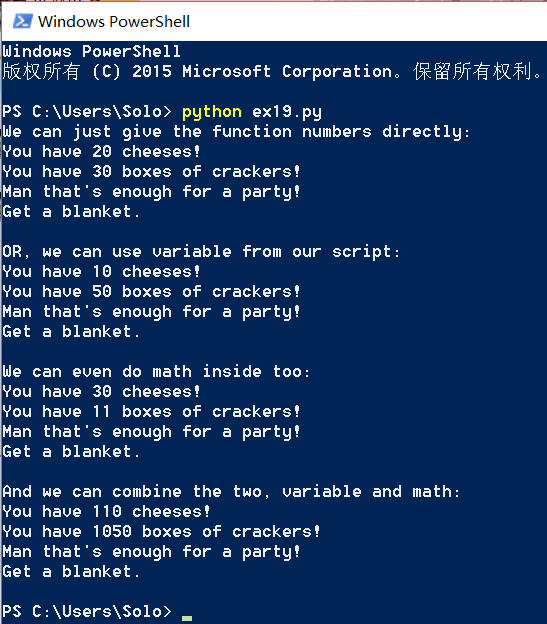《笨办法学Python》 第19课手记
本节课讲函数和变量(变量和函数的关系是变量作为做函数的参数,定义时是形参,使用时是实参),内容比较简单。
源代码如下:
def cheese_and_crackers(cheese_count, boxes_of_crakers): #定义一个函数,括号里面是形参
print "You have %d cheeses!" % cheese_count #以下为函数主体,请注意print前面的缩进必须保持一致
print "You have %d boxes of crackers!" % boxes_of_crakers
print "Man that's enough for a party!"
print "Get a blanket.
"
print "We can just give the function numbers directly:" #直接将数值作为函数实参
cheese_and_crackers(20, 30) #调用预先定义好的函数
print "OR, we can use variable from our script:" #将数值赋值给变量,再让变量作为函数实参
amount_of_cheese = 10
amount_of_crackers = 50
cheese_and_crackers(amount_of_cheese, amount_of_crackers) #调用预先定义好的函数
print "We can even do math inside too:" #在调用函数时用表达式做函数实参,python会先计算出表达式的值
cheese_and_crackers(10+20, 5+6) #调用预先定义好的函数
print "And we can combine the two, variable and math:" #变量和表达式的混合模式做函数实参
cheese_and_crackers(amount_of_cheese + 100, amount_of_crackers + 1000)结果如下:
本节课涉及的知识
函数调用时赋给实参的四种方式:
1.直接将数值作为函数实参。
2.数值赋值给变量,再让变量作为函数实参。
3.在调用函数时用表达式做函数实参。
4.变量和表达式的混合模式做函数实参。
请仔细阅读常见问题回答,其中涉及的全局变量在这里不适合介绍,以后遇到实例再讲。
请注意,作者也提到,在你使用raw_input时要使用,int做类型转换,因为,raw_input函数处理的结果是字符而不是一个数值,字符和数值在计算机中的存储方式是不同的,参见ASⅡ码表。
